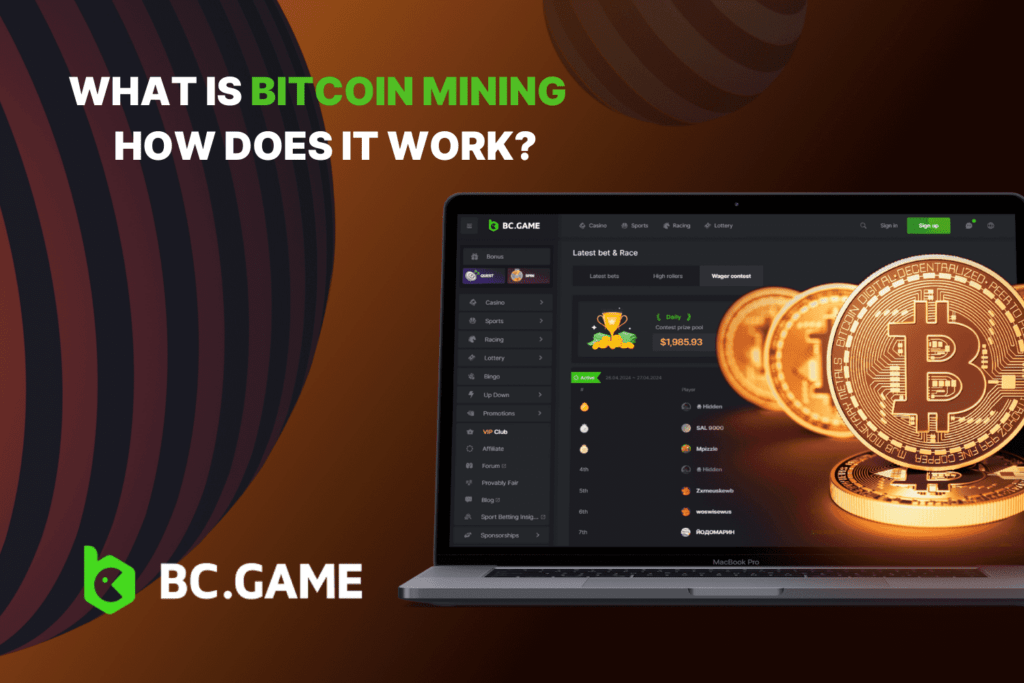
Explore the intricate landscape of cryptocurrencies, where Bitcoin mining emerges as the cornerstone of a decentralized financial paradigm shift. Uncover the enigmatic process orchestrating the birth of new Bitcoins and fortifying the security of the entire network. Join us on an expedition into the realm of Bitcoin mining, what is mining cryptocurrency, where every algorithmic move contributes to the evolution of digital finance.
What is Bitcoin Mining?
So, what is Bitcoin mining? Picture it as a modern gold rush. Miners, using powerful computers instead of pickaxes, uncover new Bitcoins and keep the cryptocurrency network safe. They achieve this by solving tricky puzzles that confirm transactions on the Bitcoin network.
Understanding Bitcoin Mining
What is cryptocurrency mining? Imagine a bustling digital mining town, where miners set up their camps (mining rigs) equipped with advanced machinery (ASICs or GPUs) to tackle cryptographic puzzles. The first to crack the code adds a new block to the blockchain, earning bitcoins and transaction fees – a modern-day gold rush in the digital realm.
It’s a global competition as miners race to validate the next block and claim rewards, with puzzle difficulty adjusting dynamically. Like historical miners upgrading tools, today’s miners invest in more powerful gear, reflecting technological advancements.
Yet, growth brings challenges. Striking digital gold becomes harder as the mining community expands. This evolution mirrors historical shifts from basic tools to sophisticated machinery.
However, like physical mining, the digital quest has environmental concerns. Bitcoin mining’s energy intensity sparks debates about sustainability and carbon footprint, bridging metaphorical comparisons with real-world resource consumption.
In essence, Bitcoin mining mirrors the historical quest for precious resources, combining competition and resource-intensive processes to extract digital gold from the cryptographic landscape.
Purpose of Bitcoin Mining
At its core, the purpose of Bitcoin mining can be likened to the meticulous maintenance of a grand ledger, documenting every transaction that takes place in the city. Imagine this ledger as a colossal book where every economic interaction, from buying a digital cup of coffee to transferring vast sums across borders, is inscribed.
To achieve this, miners engage in a complex computational race, competing to solve intricate mathematical puzzles. The first miner to solve the puzzle earns the privilege to update the ledger, adding a new block of transactions to the city’s financial history. In return for their efforts, these miners are rewarded with freshly minted bitcoins, akin to receiving a share of the city’s wealth for their vital service.
Why is this process so essential? In this bustling digital city, trust is paramount. The ledger, commonly known as the blockchain, serves as an incorruptible record of all transactions. Through the diligence of miners, the city ensures the authenticity of each transaction, safeguarding against fraud and manipulation.
Beyond the immediate benefits, Bitcoin mining mirrors a communal effort to maintain the city’s financial system. It promotes decentralization, preventing any single entity from monopolizing control. Each miner is a guardian of the city’s economic well-being, collectively contributing to its resilience and independence.
However, the journey of a miner is not without challenges. The digital landscape is vast, and the puzzles are designed to be progressively harder, requiring ever-increasing computational power. Miners invest in powerful hardware, akin to pioneers acquiring sturdy tools for their trade. As the city grows, so does the complexity of the puzzles, ensuring that the process remains both challenging and fair.
How Bitcoin Mining works
So, imagine Bitcoin as a digital currency, right? What does mining Bitcoin mean? Now, to make sure transactions are legit and secure, we need a way to validate them. That’s where mining comes in, and it’s kind of like the backbone of the whole Bitcoin system.
Think of miners as the auditors of the digital world. They’re computer whizzes who use their machines to solve complex math problems. These problems are so tricky that they require a lot of computational power to crack. And that’s where the term “mining” comes from – it’s like digging through these complex mathematical puzzles.
Now, these math problems are the key to validating transactions. When someone wants to send Bitcoin to someone else, that transaction gets thrown into a virtual pile with a bunch of others. Miners then race to solve the puzzle associated with that pile.
The first miner to crack the code gets to add the block of transactions to the blockchain. And here’s the cool part – the blockchain is like a public ledger that records all Bitcoin transactions ever made. So, when a miner successfully adds a block, it’s like saying, “Hey, these transactions are legit, and everyone can see it!”
Now, why would miners bother with all this work? Well, besides being the unsung heroes of the Bitcoin world, they also get rewarded. For every block they add, they earn newly minted Bitcoin and transaction fees from the users involved. It’s an incentive to keep the system running smoothly.
But here’s the catch – the difficulty of these math problems adjusts over time. It’s like a built-in security measure to make sure new blocks aren’t added too quickly. So, as more miners join the race, it doesn’t become a cakewalk – the puzzles just get tougher.
Bitcoin mining is like a digital gold rush, where miners use their computational power to validate transactions, secure the network, and, in the process, earn some shiny new Bitcoin for themselves. It’s a crucial part of how the whole decentralized, trustless system of Bitcoin operates.
Types of Cryptocurrency mining
Mining is the process by which new cryptocurrencies are created and transactions are verified and added to the blockchain. Here are some common types of how do you mine Bitcoin:
| Proof of Work (PoW) | This is the original and most widely used method of how to mine Bitcoin. In PoW, miners compete to solve complex mathematical puzzles, and the first one to solve it gets the right to add a new block to the blockchain. Bitcoin and Litecoin are notable examples that use PoW. However, PoW has faced criticism for its energy-intensive nature. |
| Proof of Stake (PoS) | PoS is an alternative to PoW and doesn’t require miners to solve complex puzzles. Instead, validators are chosen to create new blocks based on the amount of cryptocurrency they hold and are willing to “stake” as collateral. PoS is considered more energy-efficient compared to PoW. Ethereum is transitioning from PoW to PoS with Ethereum 2.0. |
| CPU Mining | In the early days of cryptocurrencies like Bitcoin, mining could be done using a regular computer’s central processing unit (CPU). However, as the difficulty of mining increased, specialized hardware like ASICs (Application-Specific Integrated Circuits) became necessary for efficient mining. |
| GPU Mining | Graphics processing units (GPUs) are more powerful than CPUs and became popular for mining, especially during the altcoin boom. Ethereum, for instance, is often mined using GPUs. GPU mining is more accessible to individual miners compared to ASICs. |
| ASIC Mining | ASICs are specialized hardware designed solely for mining crypto. They are highly efficient and outperform both CPUs and GPUs in terms of mining speed. However, they are expensive and less versatile, as they can only mine specific cryptocurrencies for which they are designed. |
| Cloud Mining | Cloud mining allows individuals to rent mining power from remote data centers. This is a more convenient option for those who don’t want to invest in and manage their own mining hardware. However, it comes with the risk of scams and fraudulent services. |
| Browser Mining | Some cryptocurrencies allow mining directly through a web browser. This is typically less resource-intensive and user-friendly but may not yield significant profits. It’s a way for websites to monetize traffic without displaying traditional ads. |
| Mobile Mining | A few cryptocurrencies have experimented with mobile mining, allowing users to mine using their smartphones. However, the limited processing power of mobile devices makes this method less efficient compared to traditional mining setups. |
Blockchain and Proof-of-Work
Proof-of-Work, which is the consensus algorithm that underpins many blockchains, including the most famous one, Bitcoin. PoW is like the engine running the blockchain train. Its primary purpose is to validate transactions and create new blocks by solving complex mathematical puzzles.
Imagine a race where miners (computers in the network) compete to solve a puzzle. The puzzle is hard to crack but easy to verify once solved. The first miner to solve it gets the right to add a new block to the blockchain and is rewarded with newly minted cryptocurrency (like Bitcoin). This process not only secures the network but also regulates the creation of new digital coins, preventing fraud and abuse.
However, PoW has its critics. Some argue its energy-intensive, as miners need powerful hardware and use a significant amount of electricity to compete in the puzzle-solving race. This has led to discussions about the environmental impact of PoW-based cryptocurrencies. In response, there are alternative consensus mechanisms, like Proof-of-Stake (PoS), designed to be more energy-efficient.
Mining Nodes and Miners
Imagine the blockchain as a digital ledger, a shared record of transactions. Mining nodes are like the backbone of this system. They are powerful computers spread across the network, and their job is to validate and add new transactions to the blockchain.
Now, miners are the unsung heroes. They’re the ones running these mining nodes. Their main task is to solve complex mathematical problems, sort of like solving puzzles. When they crack the code, they get the chance to add a new block of transactions to the blockchain. This process is known as mining.
Think of miners as digital prospectors. Instead of digging in the ground for gold, they’re using their computer power to discover new blocks of transactions. The first one to solve the puzzle gets a reward in the form of cryptocurrency, like Bitcoin. It’s like a digital paycheck for their efforts.
Mining nodes and miners work together to maintain the integrity and security of the blockchain. They ensure that transactions are valid and that no one can manipulate the system.

Mining Hardware
Mining hardware is the backbone of cryptocurrency mining, a process where you contribute your computational power to solve complex mathematical problems and, in return, earn some shiny new digital coins. It’s like digging for gold in the virtual world.
Think of mining rigs as the pickaxes and shovels of the digital age. These powerful machines are designed to crunch numbers at lightning speed, aiming to be the first to solve cryptographic puzzles and validate transactions on a blockchain network. The faster your hardware, the better your chances of striking crypto gold.
Graphics Processing Units (GPUs) and Application-Specific Integrated Circuits (ASICs) are the rockstars of mining hardware. GPUs are versatile multitaskers, excelling at handling various types of calculations, while ASICs are specialized beasts created solely for mining, offering unparalleled efficiency in solving the specific algorithms required.
Imagine setting up your mining rig as if you’re assembling a high-tech puzzle. You carefully piece together components like the motherboard, CPU, memory, and, of course, the powerhouse GPU or ASIC. It’s like building your own digital treasure hunter, ready to conquer the virtual landscapes.
Mining Process
How do you mine cryptocurrency? Imagine Bitcoin mining like being a digital gold prospector. Instead of a pickaxe, though, you’ve got a powerful computer. Your job? Not to sift through rocks, but to process transactions on the Bitcoin network and, in the process, unearth some shiny new Bitcoins.
The Hash
Imagine you have a super-secret recipe book, and you want to create a unique fingerprint for each recipe. That’s kind of like what a hash is in the digital world. It’s a magical process that takes a bunch of information, like your recipe ingredients, and turns it into a unique code. This code is the recipe’s fingerprint – we call it a hash.
Target hash and Nonce
Now, think of the target hash like Goldilocks looking for the perfect bowl of porridge – not too hot, not too cold. Miners are on a quest to find a hash that’s just right. The network sets a standard, saying, “Hey, your hash should start with a certain number of zeros!” That’s the Goldilocks standard or the target hash.
Here’s where it gets interesting. Miners, the digital chefs, have this secret sauce called the nonce. It’s like a secret ingredient they can tweak. They keep changing the nonce and mixing it with their data until they find a hash that satisfies the Goldilocks standard – starting with the right number of zeros. The nonce is their way of experimenting until they get that perfect recipe fingerprint.
So, hashing, target hash, and nonce are like the ingredients, Goldilocks standard, and secret sauce in the digital recipe book of miners. It’s a constant quest for the perfect blend that unlocks the next chapter in the blockchain adventure.
Block Rewards
Every time a miner successfully solves a puzzle and adds a new block to the blockchain (which is like the big digital ledger everyone’s keeping), they get a little treat – that’s the block reward.
The block reward usually consists of two parts: the freshly minted cryptocurrency (like Bitcoin) and some transaction fees. It’s kind of like getting both a salary and tips. The newly minted coins are created out of thin air and given to the miner as a reward for their effort and computational power. Meanwhile, the transaction fees are the little bonuses from people who paid a bit extra to get their transactions processed faster.
It’s not just a one-time thing either. This happens every time a miner successfully adds a block, creating a steady flow of rewards. It’s the system’s way of keeping these digital superheroes motivated to keep the whole network secure and transactions flowing.
Mining Pools
What is mining Bitcoin? Solo mining is like being a lone wolf prospector. You’ve got your pickaxe, your hat, and you’re out there in the digital wilderness, hoping to stumble upon a shiny nugget (solving a block and getting a reward). But, truth be told, it’s a vast landscape, and finding gold on your own can be like looking for a needle in a haystack.
Mining pools are the team players of the digital gold rush. Instead of going at it alone, miners join forces in these pools. It’s like forming a posse in the wild west to cover more ground and improve your chances of finding that elusive treasure.
Miners in a pool combine their computing power, sort of like pooling their resources and expertise in the gold rush. They work together to solve the complex mathematical problems required to mine a block. Once a block is successfully mined, the reward is shared among all the contributors based on their individual efforts.
Is Bitcoin Mining Profitable?
The profitability of Bitcoin mining depends on various factors, and these factors can change over time. Here are some key considerations of how does crypto mining work and make your profit:
- Mining Difficulty
- Bitcoin Price
- Mining Hardware Efficiency
- Electricity Costs
- Mining Pool Participation
- Operational Costs and Maintenance
- Regulatory Environment
Challenges and Future Trends
The challenges and future trends in the cryptocurrency and blockchain space are dynamic and subject to change of how does cryptomining work.
Energy Consumption
As the cryptocurrency space evolves, addressing the energy consumption associated with mining remains a critical challenge. The industry is exploring various solutions to balance the need for security and decentralization with environmental sustainability.
Some blockchain projects are exploring or transitioning to PoS or other consensus mechanisms that require significantly less energy. PoS validates transactions and creates new blocks based on the amount of cryptocurrency held by a participant, eliminating the need for energy-intensive mining.
Potential Future Developments in Bitcoin Mining
- Decentralized Finance (DeFi)
- Non-Fungible Tokens (NFTs)
- Central Bank Digital Currencies (CBDCs
- Blockchain Interoperability
- Enhancements in Blockchain Technology
- Sustainability Initiatives













